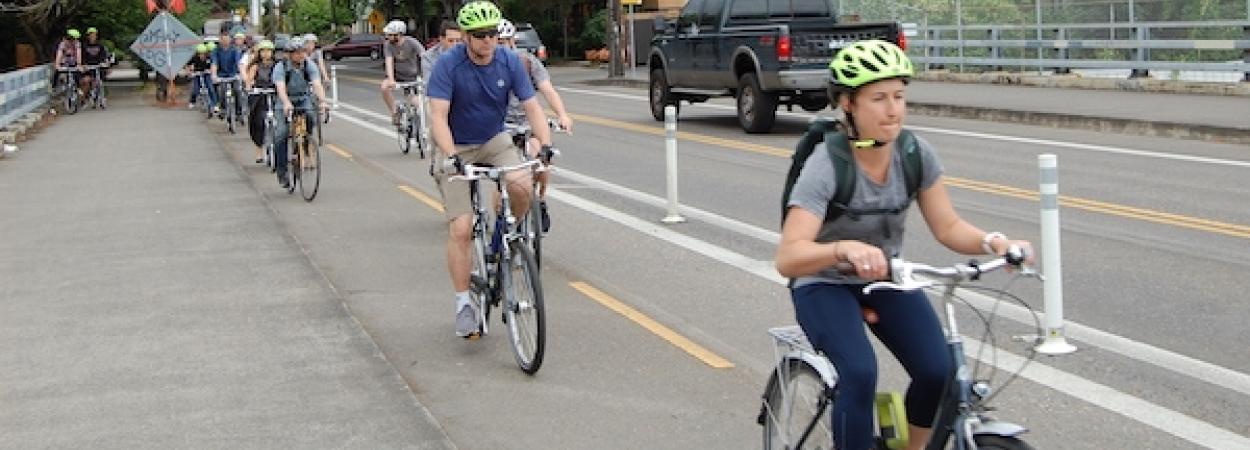Subcontract: NCHRP 15-74 Safety Evaluation of On-Street Bicycle Facility Design Features
Sponsor: National Cooperative Highway Research Program (NCHRP)
Research Team Lead: Dr. Bahar Dadashova, Texas A&M Transportation Institute
Investigators: Christopher Monsere, Sirisha Kothuri and Nathan McNeil of Portland State University; and Toole Design Group
In recent years, there have been over 600 bicyclist fatalities annually in the United States. This sobering statistic has motivated a number of recent studies, including the recently released National Transportation Safety Board study, “Bicyclist Safety on US Roadways: Crash Risks and Countermeasures (PDF). ” That report notes that midblock crashes account for a disproportionate number of bicyclist fatalities and severe crashes, and that separated on-street bicycle facilities may reduce the likelihood of these crashes. However, there are only limited data on the safety outcomes of separated on-street bikeways in the U.S., despite their increasing popularity compared to non-separated alternatives.
On-street bicycle facilities provide exclusive travel lanes for bicyclists within the roadway. Non-separated on-street bicycle facilities are horizontally delineated from motor vehicle traffic by pavement markings, such as a painted buffer or striping. Some non-separated facilities are colored either over their entire length or through conflict areas. Separated on-street bicycle facilities are separated from motor vehicle traffic both horizontally and vertically by flexible delineators, curbs, parking lanes, or other barriers.
In a newly contracted project funded by the National Cooperative Highway Research Program (NCHRP), Texas A&M Transportation Institute with support from Portland State University and Toole Design Group will work to provide practitioners at state departments of transportation (DOTs) and other transportation agencies with data-driven guidelines for selecting context-appropriate bikeway design features. This will support the implementation of safety improvements to existing separated and non-separated on-street bicycle facilities, as well as the planning of new facilities. The guidelines will be based on an up-to-date, quantitative analysis of crash patterns as well as an evaluation of the roadway characteristics, land use patterns, and human factors that increase conflicts and the risk and severity of midblock crashes that involve bicyclists.
Seeking to address safety concerns and promote bicycling in their communities, many state and local DOTs have already installed separated bicycle facilities. Many more agencies are exploring the potential of doing the same, but need more detailed information on anticipated safety improvements of specific design features for a range of sites and contexts. The new guidance from this project will deepen our understanding of the relationship between design features and the risk of midblock (non-intersection) bicycle-involved crashes and conflicts. The research team will also identify implementation pathways that will allow practitioners to put the results of this project into practice, and directly disseminate the project results with practitioners and state DOTs.
Relatedly, this same team of PSU researchers has joined a second contract lead by Toole Design Group: NCHRP 15-73 Design Options to Reduce Turning Motor Vehicle – Bicycle Conflicts at Controlled Intersections.
The project began in September 2020, and is expected to conclude in August 2023. To stay updated about its progress and to hear about findings from other PSU transportation research, subscribe to our monthly TREC newsletter.
The Transportation Research and Education Center (TREC) at Portland State University is home to the National Institute for Transportation and Communities (NITC), the Initiative for Bicycle and Pedestrian Innovation (IBPI), and other transportation programs. TREC produces research and tools for transportation decision makers, develops K-12 curriculum to expand the diversity and capacity of the workforce, and engages students and professionals through education.




